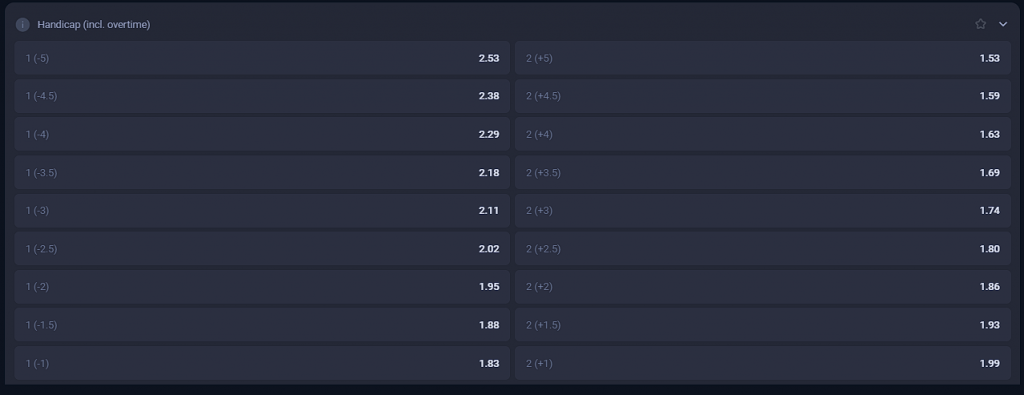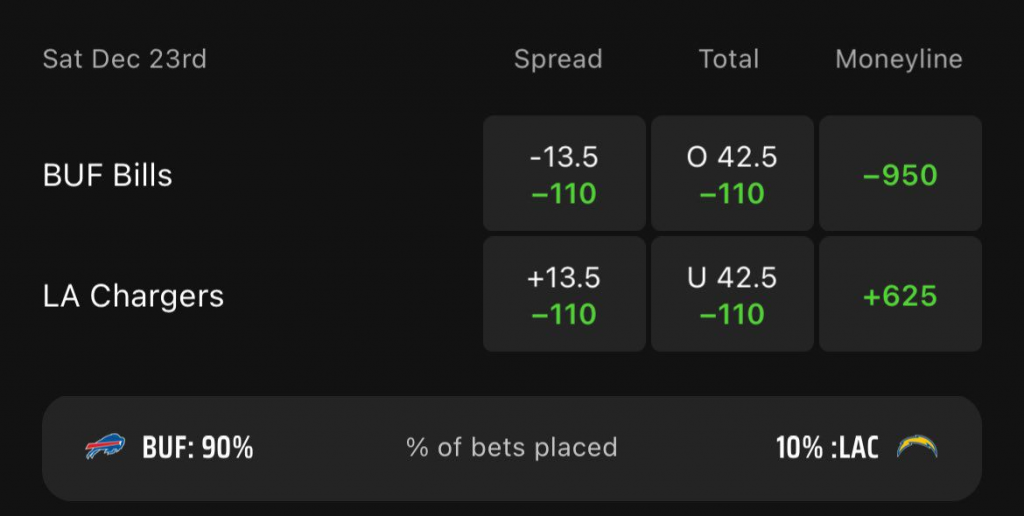This website utilizes anonymous usage data to provide the most helpful experience for visitors. Information about how the site is accessed is stored and analyzed without identifying individual users. This allows our team to understand which sections of the website are found most useful so we can focus our efforts on improving those areas for all users. We respect the privacy of those who access our content and aim to make the site as beneficial as possible for everyone.
- Crypto Betting
-
-
Crypto Available

First Deposit Bonus 125% Up To $1000

100% up to $100 (or equivalent in crypto)
-
- eSports Betting
-
-
Crypto Available

First Deposit Bonus 125% Up To $1000

100% up to $100 (or equivalent in crypto)
-
- By Sport
-
-
Crypto Available

First Deposit Bonus 125% Up To $1000

100% up to $100 (or equivalent in crypto)
-
- By Type
-
-
Crypto Available

First Deposit Bonus 125% Up To $1000
-
- SportsBooks
-
-
Crypto Available

First Deposit Bonus 125% Up To $1000

100% up to $100 (or equivalent in crypto)
-
- Odds & Picks
- Education
How Does Spread Betting Work?
I know that newcomers may occasionally be perplexed by a bunch of sports stakes. Since I saw numerous questions about different stakes on various thematic forums, I decided to describe well-known wagering types in our blog. What is spread betting? Obviously, I focus on this theme.
Spread betting is a well-known wager format most frequently used in sports such as college football, the NFL, the NBA, and more. Numerous sports fans prefer this betting type to create winning strategies and experience new emotions. I have covered all the details based on my experience. So, let’s start our journey.
What Is A Point Spread?
A “point spread” is a number appointed by bookmakers to even the playing field between competitors. Simply put, it is a handicap between two teams participating in the match. Therefore, you are offered to bet on the margin of victory of a picked team.

As not all teams have similar skills, oddsmakers utilize spread wagering to level the playing chances. The meaning of spread betting can be described as an excellent balancer when comparing teams. As a rule, this wagering type is commonly used for NBA league, NCAA, NFL, and college football. In basketball games, the spread is frequently called the run line. Moreover, it is known as the puck line in hockey.
Let’s explore an example. After the bookmaker sets point spread, you can see numbers near each team. If the Buffalo Bills are a 5-point favorite over the Pittsburgh Steelers, it’ll be presented as “-5″. Thus, the team from Buffalo needs to win by more than five points. So, the minus means that you need to take their score at the end of the match and subtract 5 points from it.
On the other hand, the Pittsburgh Steelers will have +5. It means that the team has to lose by fewer than five points or win the match for your winning stake. So, even if the outsider does not win the game but loses by less than 5 points, your stake will win.
How To Read A Point Spread
Obviously, to benefit from point spread betting, you need to deal with the reading of terms of this wager market. As a professional bettor, I can explain how to understand the point spread correctly. So, let’s proceed with the topic in my review below.
Handicap
A handicap or spread is a wagering line indicated by a bookmaker to even out the playing field between teams in the chosen match. The handicap is created to disadvantage the front-runner and give a favor to the underdog. The main goal of handicap is to make the wagering more reasonable and more balanced for both sides.

The handicap shows the number of points that the front-runner may potentially win or the underdog can lose. For instance, if the handicap for an NFL match is set at -6 for the favorite team, then it must win the game by over 6 points for a wager to win. In contrast, if the handicap is +6 for the weaker team, then it may lose the match by up to five points and still be deemed a winner against the spread.
Favorite
A favorite or front-runner in spread betting is a team that is favored to win the match by a specific number of points. So, if you place stakes against the spread, it means that you not only bet on a team to win but also wager on the spread.

Let me give you an example. The bookmaker set the spread at -7 on the Buffalo Bills and +7 on the Pittsburgh Steelers. In this case, the Buffalo Bills are indicated as the front-runner. So, you need to bet not only on the winning of this team, but also you should be confident that the Buffalo Bills win by more than 7 points.
Keep in mind that betting on the favorite against the spread cannot guarantee a winning result. Why? A weaker team may still cover the spread by losing by fewer points than the indicated spread. It seems obvious that wagering against the spread may offer a substantial winning sum compared to betting on the favorite. Nonetheless, it may also be a riskier stake, as it stands that the selected team must receive a victory by a specific margin.
Underdog
An outsider is a team that may fail in the match by a particular number of points according to the bookmaker’s predictions. If you place a stake on the underdog against the spread, it must win the game outright or lose by less than the indicated point spread for your stake to win.
To be honest, I always count on considerable payouts when I bet on the weaker team against the spread compared to wagering on the front-runner. Still, I realize that it is a dangerous idea, as the underdog is expected to fail the match. Nonetheless, if the outsider pulls off an upset or covers the spread, I will grab a substantial payout.
Vig
“Vig,” shortened from vigorish, defies the fee that a particular bookmaker charges for placing a bet. The term “juice” is widely used as well, meaning a commission that I, being in the role of a bettor, need to pay to wager. The vig is built into the odds, so in the case when I am looking for a bookmaker, I pay attention to the final odds.
Most often, the vig is shown as a percentage of the total betting amount and is traditionally around 10%. Let’s imagine I want to bet $50 on a match with a vig of 55%. The amount of money I will need to risk is $55. In case of my win, I will claim $50. Nevertheless, if my prediction fails, I will lose the full sum ($55).
Hook
The term “hook” is also frequently used in spread betting. It stands for the half-point that has the potential to change the wagering outcome despite the whole following number. Just look at an example to better understand the principle of this term.
Imagine that the betting site gives the point spread: -4.5 on Detroit Lions and +4.5 on Tampa Bay. The addition of 0.5 (half-point) means that a tie will not be. If the Detroit Lions wins the match by exactly 4 points, users who bet on Tampa will lose. In contrast, bettors who preferred the Detroit Lions would win. This 0.5 is the hook that prevents a push.
How To Bet The Spread
How does spread betting work? It’s time to describe the wagering process so that you may try this market without worrying. I have crafted a step-by-step guide below:
- Stick with the finest bookmaker (you can pick one from the SafeHamsters website) and choose a suitable sports type (e.g., NFL, NBA, or soccer).
- Opt for the point spread market (as a rule, it will have the second or third place among available bet types and go after the outright winner). Check the proposed line and point spread variants offered by the bookmaker.
- Analyze the team’s background, their last matches and results, players’ injuries, and weather conditions when the game is planned.
- Place your bet on the underdog or favorite (it depends on your preferences and odds). Keep in mind that you need to wager the sum you may use without financial ruin.
Finally, if your predictions come true, you can claim your winnings from the spread betting market. Do not be upset if you lose, as you may get some insights from the process to use them in the future. I recommend analyzing your strategy and trying again next time.
Potential Outcomes
As usual, the spread betting market may have three potential outcomes. One is when the favorite covers the spread, and the second is when the underdog covers the spread. Moreover, occasionally, bettors may face a push as an outcome. Since users do not always understand what these results mean, especially with spreads, I decided to explain them below.
Favorite Covers The Spread
This result means that the favored team has won the game by a margin greater than the points spread indicated by the sportsbook. Do you think this is perplexing? Let’s explore the example. I bet on the Buffalo Bills that they are favored by 6 points over the Pittsburgh Steelers; the spread would be -6 for the Buffalo Bills and +6 for the Pittsburgh Steelers. If the favorite (in my case, Buffalo Bills) wins the match by over 7 points, it covers the spread.
Underdog Covers The Spread
This outcome means that the outsider team has won the match or lost by fewer points than the spread indicated by the betting site. I can describe it in the example of the Buffalo Bills and Pittsburgh Steelers. If the Pittsburgh Steelers were an outsider with a +6 spread, they must win the match or lose by 5 points or fewer. In this case, the underdog will cover the spread.
A “Push”
The push happens when the spread is set with whole numbers. This outcome means that the match’s result lands on the occurrence point spread indicated by the bookmaker.
Logically, that no bettor, no sportsbook loses or wins. The sum of the stake is traditionally returned to the user. Thus, if the point spread for the Buffalo Bills is -6, for the Pittsburgh Steelers it is +6, and the first team wins by 6 points, it results in a push. Consequently, no sports enthusiast wins in this spread betting market and may only return their stake amount.
Risks And Benefits Of Spread Betting
Besides explaining spread betting, I advise you to learn about the potential risks and advantages of this wagering market. So, let’s start.
Risks
If you ask my opinion, I may highlight several potential risks in the list below:
- Unpredictable results. Point spread wagering may be unpredictable since the chosen team may win the match but not cover the spread. Consequently, you can lose your stake. On top of that, the game outcome depends on the weather, players’ injuries, and other additional conditions.
- Substantial vig. Do you remember that I have noted this factor above? Bookmakers include 10% of vig, which means that you need to pay more to profit from the spread betting market.
- Overvaluing leaders. Periodically, sports enthusiasts overvalue their favorite team and bet more than necessary. In that case, they may lose everything.
Of course, I advise you to wager periodically with pauses to avoid provoking the appearance of betting addiction. Use betting sites as a hobby for your spare time
Benefits
When it comes to benefits, I may describe a few facets here. Take a look at the list to uncover them:
- There are more wagering options. The spread betting market enables you to wager on both underdog and favorite teams, giving you more opportunities to profit.
- Potential for considerable payouts. Wagering on the underdog allows you to cover the spread and receive a higher payout compared to traditional betting on the favorite.
- Boosted wagering interest. Thanks to the point spreads, you can count on a fascinating game. What do I mean? Even if the selected team has a greater advantage to win, the spread may make the game outcome more uncertain, leading to boosted wagering interest.
So, as my experience shows, the point spread may provide good profit and fun. Analyze the market, manage your risks, and try new opportunitie
Best Strategies for Spread Betting
As a regular bettor who frequently uses the point spread market, I know a few crucial strategies that may help to win. I prefer the line movement method, comparing spread and moneyline odds and other well-known approaches. Continue reading to learn essential spread betting tips and strategies.
Line Movement
This excellent strategy involves tracking changes in the spread indicated by the bookmaker. The only thing you need to do is closely monitor the line movement and seek opportunities to benefit from changes in the wagering lines. Moreover, I would advise paying attention to any reverse line movement, which occurs when the point spread moves on the opposite side of the wagering percentages.
Furthermore, you may utilize multiple bookmakers to compare wagering lines and find the finest odds in the spread betting market. In our blog, you can find a guide on arbitrage betting, where you can learn the main principle of such a wagering method.
Researching the Playing Field
Of course, I recommend analyzing the playing field as a part of spread betting strategies. In my opinion, field research is crucial for making the right decision. You may review the features of the playing field where the match is planned and whether the teams have already played there before. If the game is outdoors, check the weather forecast on the day of the match. All these moments have a significant impact on the future outcome of the game.
Home-Field Advantage
Do not overlook the team’s home-field advantage when planning to bet on the point spread. In most cases, teams play better on their native fields and may show greater results. Watching previous teams’ games and comparing home/away results is not challenging. Thus, you can have a better sense of how they play in various environments, and your spread betting decisions will be easier.
Analyzing Moneyline Odds vs. Spread Odds
I also believe that finding the finest value between the spread odds and moneyline is an essential part of successful wagering. Therefore, I recommend evaluating the point spread before, as it helps you determine the profit. If you see that the point spread is too high or too low, you should try moneyline bets. Alternatively, analyze the moneyline odds and compare them to the point spread ones. If they are better, select this market and try your luck.
Conclusion
So, what is spread betting? It stands for a wagering market that allows sports enthusiasts to bet more profitably and professionally. “Spread” is also known as a margin, and it levels the playing conditions between opponents in one game. I have covered my experience and thoughts in this article, and they may help you understand the concept of point spread betting. Thus, you may try this approach to make successful wagering decisions. So, I wish you good luck, high odds, and the finest results!




